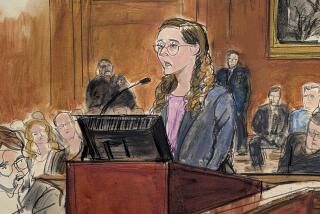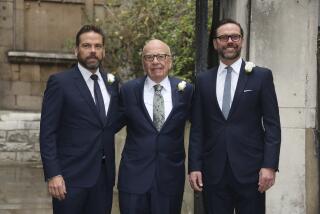Book review: ‘War at the Wall Street Journal’ by Sarah Ellison
- Share via
In the Wall Street Journal that Rupert Murdoch took over in 2007, one regular feature was the “tick tock,” an inside-the-boardroom reconstruction of a big deal.
Three years after the News Corp. chairman defied business logic and bid $5.6 billion for Dow Jones, the Journal’s supposedly impregnable proprietor, the journalist who covered the deal for the paper has served up a book as devastatingly definitive as any Journal tick tock.
Her account comes 18 months after Michael Wolff, a veteran mogul chronicler, delivered his portrait of Murdoch’s quixotic deal, “The Man Who Owns the News.”
In her book, “War at the Wall Street Journal,” Sarah Ellison, by contrast, offers a more rigorously sourced account that lacks some of Wolff’s color about the dynamics of the Murdoch dynasty. But it offers the authoritative portrait of Dow Jones’ newsroom, boardroom and dysfunctional controlling clan, the Bancrofts.
The time has given Ellison the benefit of knowing that News Corp. had to write off half the deal’s value, giving the divided Bancrofts the last laugh. She also brings an insider’s insight to the cultural and editorial upheavals the Journal went through after the deal closed.
The book is strong on the eccentric Bancrofts, with details about cocaine use, bisexuality and inheritance battles over Hermes beach towels.
In the end, a family where business talk was taboo “just gave up,” it concludes. Exhausted, their dirty laundry on display and their fate handed to bankers and lawyers wanting a deal, “they caved on everything,” Murdoch says with satisfaction.
Ellison is strongest on the Journal’s office politics. She paints Richard Zannino, chief executive at the time, as the breach in the Dow Jones dam that allowed Murdoch in. A tailored misfit among rumpled journalists, he sketched out how to approach the family for one of the mogul’s bankers as early as 2002, as the Journal reeled from the murder of its reporter Daniel Pearl.
That banker, Jimmy Lee at JPMorgan Chase, provides some of the best material. Zannino is portrayed as handing Dow Jones on a plate to Murdoch over dinner, lunch and breakfast set up by Lee.
Ellison shows Marcus Brauchli, the Journal’s managing editor, outmaneuvered by Robert Thomson, a former Financial Times U.S. managing editor who became Murdoch’s “spiritual advisor” for the deal. He then was made the Journal’s publisher and eventually its managing editor, replacing Brauchli.
Murdoch gave Wolff hours of interviews, but Ellison uses her more limited access well. A day spent on his jet happens to be the day Brauchli’s fate was sealed, a pill sweetened with a $6.4-million payoff and a ride home in the jet.
Any time spent with Murdoch, who seems unable to stop thinking aloud, yields tantalizing snippets, such as the image of former British Prime Minister Tony Blair guffawing at a quip about President Obama.
Ellison disparages the Journal’s new direction — “breathless, naive and attention-getting,” increasingly partisan in its news coverage and featuring front-page photos of Tiger Woods.
Her harshest critique is that the changes wrought by Murdoch and Thomson left the newsroom “a mess” just as it was hit by the biggest downturn — and the biggest financial story — since the Great Depression. “The paper didn’t muster coverage to match the historic nature of the moment,” she says.
Murdoch’s Journal remains a work in progress, now fighting the New York Times in its home market. Ellison captures its owner’s erratic strategy well, noting how “it seemed that Murdoch wasn’t exactly certain what he wanted to do with the paper he had coveted for 20 years.”
Having first mused aloud about ditching online subscriptions to the Journal, Murdoch has now embraced the idea of charging for all his empire’s news, leaving an urgent question hanging at the end of the book: “What was Murdoch’s content worth?”
Edgecliffe-Johnson is the New York-based media editor of the Financial Times of London, in which this review first appeared.
More to Read
Sign up for our Book Club newsletter
Get the latest news, events and more from the Los Angeles Times Book Club, and help us get L.A. reading and talking.
You may occasionally receive promotional content from the Los Angeles Times.







